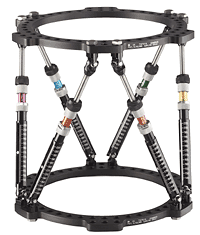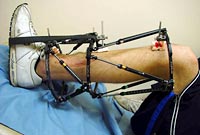98% union rate reported with Taylor spatial frame
The patients' compliance in regularly adjusting the device was high and may have contributed to good outcomes.
![BOA Technological Advancements Awards [icon]](/~/media/images/news/print/orthopaedics-today-europe/2004/11_november/boataa2004_270_115_1639.jpg) British orthopaedic surgeons said they successfully
used Taylor spatial frame fixators and a computerized custom prescription for
adjusting them in 100 cases involving leg length correction, fracture healing,
resolution of nonunions or correction of deformity.
British orthopaedic surgeons said they successfully
used Taylor spatial frame fixators and a computerized custom prescription for
adjusting them in 100 cases involving leg length correction, fracture healing,
resolution of nonunions or correction of deformity.
The few complications they reported were mostly limited to a 34% rate of pin site infections. Union was achieved in approximately 98% of cases, said investigator Iain McFadyen, FRCS, of the Bristol Limb Reconstruction Unit in Bristol, England. He presented the results at the British Orthopaedic Association Annual Congress in Manchester, England.
|
COURTESY OF SMITH & NEPHEW |
We found that the spatial frame is an extremely versatile treatment option with a high degree of accuracy, particularly useful in complicated cases, with good patient compliance mainly because of their involvement in the treatment, McFadyen said.
The study by McFadyen and co-investigator Roger Atkins, FRCS, of the 3-D Ilizarov-like fixator earned them the Orthopaedics Today Technological Advancement Award.
The Taylor spatial frame, manufactured by Smith & Nephew, is an external ring fixator. McFadyen said it is unique because it functions as a parallel processor, able to correct all three planes of a deformity simultaneously. J. Charles Taylor, MD, an orthopaedic surgeon in Memphis, U.S.A., developed the spatial frame.
In the first 100 consecutive cases that McFadyen reported on, researchers used the fixator mainly in the tibia and femur. There were 94 patients, six of whom wore two frames simultaneously. Their mean age was 40 years old.
In the series were applications of the device in the knee, ankle, humerus and wrist, and for a variety of indications, including bone resection and segmental bone transport with bone that was devitalized or infected.
They were all rather complicated cases; all [had] tertiary referrals and 83 of the patients had undergone previous surgery for the same condition at another institution. We employed standard Ilizarov surgical techniques using fine wires or hydroxyapatite-coated half pins. The bone was divided with percutaneous low-energy corticotomy, and distraction osteogenesis was used for lengthening, he said.
Good compliance necessary
The mean time to healing was 169 days. In the 28 deformity cases, the rate of radiological correction was 93%.
But central to all of the treatment programs was that patients performed the adjustments themselves according to a printed description, and this was as an outpatient, McFadyen said, noting that there was 100% compliance.
|
COURTESY OF IAIN MCFADYEN |
To use the system, the surgeons measured the patient's deformity clinically as well as with radiographs. Using Web-based software, they entered the parameters into the system, which then reproduced the deformity. Once the frame's mounting parameters were determined and entered into the computer program, along with the time period by which the correction was to be achieved, the system generated a prescription that gradually corrected the deformity back to anatomic.
The mean treatment time in the series was 169 days. The complications were similar to those typically seen with the Ilizarov method, McFadyen said. In addition to surgical site infections, there were four more serious complications: three surgical debridements and one extensive bone resection.
Any joint stiffness patients had while wearing the frame resolved with physical therapy after it was removed.
Investigators have used the frame in more than 200 cases. McFadyen said that treatment with the new frame is still evolving.
The frame's advantages include optimal correction of deformity and its ability to be carefully and repeatedly adjusted to the surgeon and patient's satisfaction, he said.
For more information:
- McFadyen I, Atkins RM. The Taylor spatial frame in limb reconstruction surgery: review of 100 cases. Presented at the British Orthopaedic Association Annual Congress. Sept. 15-17, 2004. Manchester, England.


